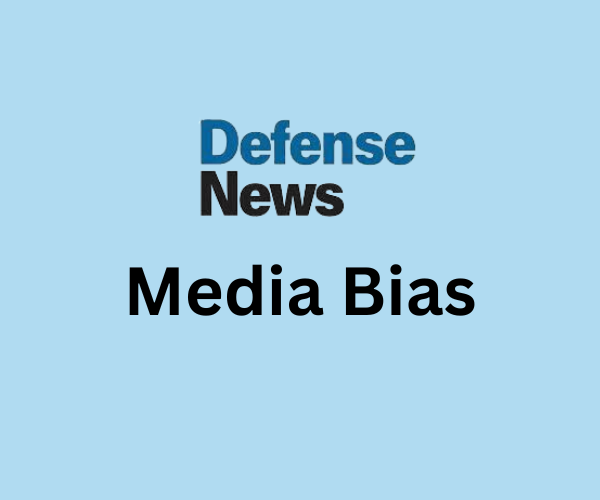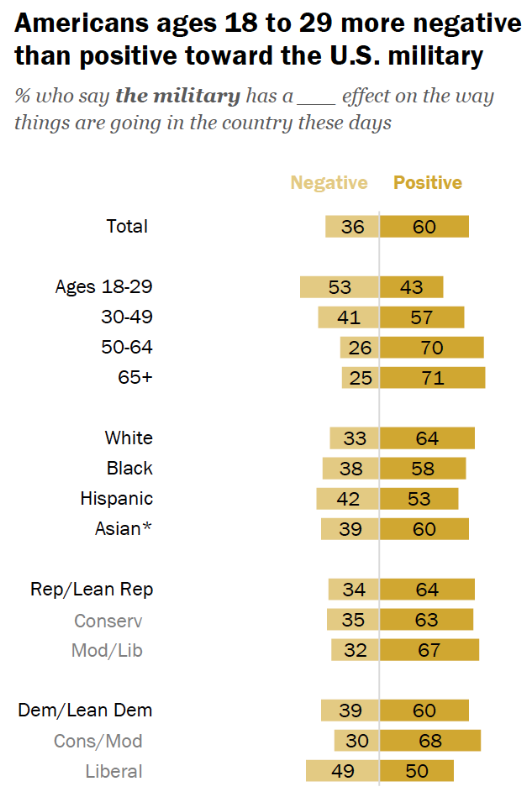
Defense News, an online and print publication established in 1986, is owned by the parent company Sightline Media Group, and by proxy, Regent. This news outlet exclusively covers news that pertains to defense-related issues, enveloping topics such as ongoing conflicts, analysis of defense policies, economics, and military-related politics. Defense News had a monthly traffic of 3.2 million people according to Similar Web, making it one of the top sources concerning defense-related topics.
Understanding that Defense News is a leading publisher within this sector, it is important to scrutinize any biases in their published content. According to Pew Research, only 50% of Liberal Democrats maintain a positive view of the military, while 63% of Conservative Republicans hold a positive view:

Source: Pew Research
In this article, we seek to understand whether the content of Defense News is biased. Within our analysis, we hope to provide an extensive overview of any bias that may be contained in their articles or opinions. In addition, it is our goal to provide insight into any factors contributing to bias in media generally.
How Does Biasly Rate News Sources?
Biasly’s algorithms produce bias ratings to help provide multiple perspectives on given articles. Biasly has analyzed 200,000+ news articles from more than 3,200 news sources through our A.I. technology and team of political analysts to find the most factual, unbiased news stories.
Biasly determines the degree of political bias in news sources by using Biasly’s Bias Meter Rating, in which Biasly’s team analyzes media sources’ reliability and bias and produces three scores, a Reliability Score that measures the accuracy of media sources; an A.I. Bias Score, evaluated by A.I.; and an Analyst Bias Score evaluated by political analysts. These scores are rated based on seven rating metrics including Tone, Tendency, Diction, Author Check, Selection/Omission, Expediency Bias, and Accuracy. These metrics help our analysts to determine the political attitude of the article.
Our A.I. machine-learning system employs natural language processing and entity-specific sentiment analysis to examine individual articles and determine their bias levels. By analyzing the key terms in an article such as policies, bias phrases, political terminologies, politicians, and their nicknames, the algorithms can rate the attitude of the text. Bias scores range from -100% and 100%, with higher negative scores being more Liberal and higher positive scores being more Conservative, and 0% being neutral.
Is Defense News Politically Biased?
Biasly rates Defense News based on A.I.-based algorithms, they rated Defense News with a Computer Bias Score of Center. With a score of Center, this outlet shows that they generally have a balanced point of view when it comes to the portrayal of information and opinions.
This balance can also be found within their general audience, with many of their readers on social media providing feedback with a range of political beliefs. In one of their recent posts on X, promoting an article “Opinion: Washington Cannot Change the Outcome of This Conflict With Military Aid, nor Can it Enter The Conflict Directly Without Risking Nuclear War”, commenters provided a variety of opinions:
“Took people this long to realize this? It’s a costly, unwinnable war. If the US wants to hedge against Russian ambitions, they should probably be doing better PR around the world. The US is losing support.”
“Wrong”
Took people this long to realize this? It’s a costly, unwinnable war. If the US wants to hedge against Russian ambitions, they should probably be doing better PR around the world.
The US is losing support.
— Your Biological Father (@DavTechUSA) May 24, 2024
Wrong
— Gabriella Dolce-Bengtsson (@gabidolceb) May 24, 2024
While there are varying biases in each opinion, these statements show that there is not a substantial majority of viewers who hold beliefs of a single side. This displays an important factor for a Center-Leaning outlet, a variety of opinions in responses result from having minimal bias towards a single side. This is one way in which a person can help them recognize whether bias exists. In attempting to navigate today’s media, understanding and uncovering bias can help one understand information to a better degree.
Before we begin, we need to discuss bias. Bias is a natural function of humans, and we can express it both consciously and unconsciously. Bias is one of the most fundamental forms of pattern recognition in humans. This isn’t to lower the bar and say that “all things are biased,” but to explain how we may come to trust certain news organizations that display coverage patterns.
On the media’s part, there is an incentive to retain audiences, encourage them to purchase subscriptions, and rate products positively. Bias is a two-way street, people want to see news stories about things they care about, and the media needs viewers to continue their operations. This creates a positive feedback loop that influences what stories are covered and from what perspective. This also explains the actions of more liberal news organizations.
Analysis of Bias in Defense News Online Articles
Since Defense News was rated Center in Biasly’s Computer A.I. Score for Bias overall, one may presume its articles are free of bias. However, this may not be the case as many factors allow them to occur, such as bias from individual authors. This section will endeavor to uncover any bias within articles published by the media source.
To determine bias within an article several factors must be considered, centrally, Tone, Diction, the Author, Tendency, and Expediency Bias.


Source: Defense News
In the article “Granger, Gallagher Leave Committee Posts as House GOP Majority Shrinks” Bryant Harris reports that the two Representatives have both committed to vacate their positions within the Committee on the Chinese Communist Party. Biasly has given this article a Rating of Extremely Liberal.
The article presents a pessimistic Tone regarding the future of the House Republican republican party, with statements such as these emphasizing it:
“At the same time, Gallagher said he would resign in April, further narrowing the House GOP’s thin majority and creating a vacant position atop the China-focused panel”
This quote emphasizes that there is a decrease in Republican influence within the House without qualifying the extent of the issue, allowing the reader to gather their own answer.
“Gallagher championed policies to “arm Taiwan to the teeth” to deter a possible Chinese invasion, while framing the Sino-U.S. rivalry as a ‘new Cold War’.”
The issue in this statement is the word “framing”, which may lead the reader to assume that the following statement he made is unreasonable.
The first aspect of this article we will analyze is Expediency Bias, referring to the use of images, titles, or summaries containing bias. This is immensely important to examine as these are the portions of the article that the reader sees often prior to the main portion of the article.
As seen above, images portraying this event were used to command the emotion of the situation. Concerned faces of reporters hoarding the representative and a somewhat distressed facial expression of Rep. Granger emphasize the controversy of the situation. This may lead the reader to assume that her exit from the committee and her choice to retire from Congress is more controversial than reality.
Additionally, the author himself has revealed that some of his views may skew in a certain direction. On his X account, he has reposted several posts of left-leaning ideas such as:
“Syria’s refugees are victims of the 21st Century’s most barbaric crimes & have been forced to flee for survival, often multiple times, into squalor. They deserve nothing but sympathy & assistance — not further discrimination, victimization or God forbid, expulsion.”
“A convicted felon should be allowed to run for president
GOP Voters
April – 17%
June 58%”
#Syria‘s refugees are victims of the 21st Century’s most barbaric crimes & have been forced to flee for survival, often multiple times, into squalor.
They deserve nothing but sympathy & assistance — not further discrimination, victimization or God forbid, expulsion.
— Charles Lister (@Charles_Lister) June 5, 2024
A convicted felon should be allowed to run for president
GOP Voters
April – 17%
June 58%YouGov #4 – 472 RV
— Political Polls (@PpollingNumbers) June 5, 2024
Analyzing the Tendency of the author in this story it can be seen that the author consistently portrays the Republican Party in a negative light. More specifically, both the Republican Party as a whole in addition to the member politicians mentioned throughout the article were presented as weak and losing influence. While the events he reported were factual, he used language in multiple areas that may mislead the reader into believing the events that occurred were more significant than reality.
In this article, Harris’s Tone, or attitude of writing, is fairly negative towards conservatives throughout, additionally, there are a few words in his Diction that may emphasize some of this bias. His emphasis on the number of Republican congress members who have recently retired for example:
“[Rep. Granger, Rep. Gallagher] had already announced they would not seek reelection this November amid a slew of Republican retirements”
The word “slew” exemplifies a large number which may lead the reader to overestimate the number of congress members affected.
Another example:
“Gallagher’s early departure will reduce the embattled House Republican majority to a one-vote margin given the resignation of Rep. Ken Buck, R-Colo., on Friday.”
The usage of “embattled” may imply to the reader an excessive level of distress regarding the Republican Party since the author did not mention specific metrics concerning the number of resignations within the story.
Most articles published by Defense News are rated Center according to Biasly. One example of this is the article “Chinese Defense Head Warns of ‘Self-Destruction’ for Taiwan Supporters” where Noah Robertson used a neutral Tone and Diction:
“Two years ago, after then-House Speaker Nancy Pelosi, D-Calif., visited Taiwan, China ended military talks with the U.S.”
Instances such as the bias reported in the former article are rare, and the majority, according to Biasly, represent similarly to the latter, leading to its overall Bias Rating of Center.
Analysis of Defense News Opinion Articles
Prior to our analysis, the distinction between opinionated articles and articles that report facts must be found. Reporting is expected to be both factual and neutral, when a person reads a report they should expect to see primary source information giving evidence of the claim. An opinion piece, in contrast, is an article where the author forms their own opinion, striving away from a purely fact-based report.
Bias is far more likely to exist when an author makes a direct opinion, this can be seen even in the title, for example in the article “Can Biden’s New Arms Policy Lead to Real Accountability for Israel?”. Here we can see this title contains an obvious bias against the Israeli Government, priming readers to view Israel in a negative context from the beginning.
Another opinion article “Three Directions The US Defense Budget Could Go” has a title that does not contain bias, thus preventing the reader from being exposed to bias before even reading the article.
Articles focused on opinion are quite rare on Defense News, as a result, these specific instances do not reflect the publication in its entirety. It is important, although, to understand the differences between fact-based reporting and opinionated articles which inherently will always contain a level of bias.
Who Owns Defense News?
Defense News is ultimately owned by Regent, a private equity firm based out of Beverly Hills California. The founder and chairman of the board, Michael Reistein, who in the early stages of his career worked as an intern under the Reagan Administration, can exact significant influence over the news source. However, this early step in his career did not seem to skew his influence on his subsidiary in Defense News, as they according to Biasly, remain relatively neutral in their reporting.
How to Evaluate and Uncover Bias
It can often be difficult to tell if the news you watch is biased. If you have settled on a news channel, it’s usually because you trust the information you are gaining. Unfortunately, many trust the information they are hearing because it confirms what they already believe. This is referred to as “confirmation bias.” It is important to challenge your beliefs and get third-party verification that what you are hearing is the full story. This is why we recommend using Biasly to compare different news stories side-by-side using our bias ratings to figure out what both sides think of a political issue.
Biasly gave Defense News a Bias Score of Center meaning overall they present minimal bias in their reporting. That does not mean however that in the case of individual articles, there isn’t bias. Almost every article at some point will contain a certain level of bias, however, being vigilant in recognizing these can make the reader more aware, and as a result more knowledgeable. Using tools and websites like Biasly can be extremely useful in providing insight into the bias of authors, news outlets, and articles.























